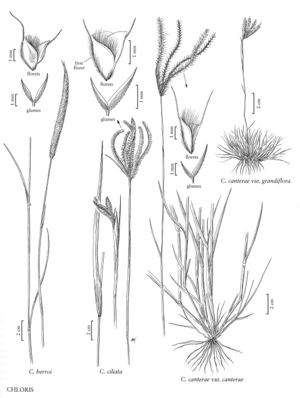Difference between revisions of "Chloris canterae var. canterae"
Treatment appears in FNA Volume 25. Treatment on page 208.
FNA>Volume Importer |
imported>Volume Importer |
||
| Line 36: | Line 36: | ||
|publication year= | |publication year= | ||
|special status= | |special status= | ||
| − | |source xml=https:// | + | |source xml=https://bibilujan@bitbucket.org/aafc-mbb/fna-data-curation.git/src/bb6b7e3a7de7d3b7888a1ad48c7fd8f5c722d8d6/coarse_grained_fna_xml/V25/V25_794.xml |
|subfamily=Poaceae subfam. Chloridoideae | |subfamily=Poaceae subfam. Chloridoideae | ||
|tribe=Poaceae tribe Cynodonteae | |tribe=Poaceae tribe Cynodonteae | ||
Revision as of 22:05, 27 May 2020
Plants loosely cespitose. Culms to 100 cm. Leaves primarily cauline; blades 2.5-6 mm wide, flat. Panicles with 2-9 branches; branches (4)5-14 cm. 2n = 36.
Discussion
Chloris canterae var. canterae has been collected in Texas and Louisiana. In South America, it grows on moist soils of the campo in Paraguay, southern Brazil, and northeastern Argentina.
Selected References
None.
Lower Taxa
None.
... more about "Chloris canterae var. canterae"
Mich. +, Del. +, Ariz. +, N.Mex. +, Pacific Islands (Hawaii) +, Miss. +, Tenn. +, Fla. +, Wyo. +, Puerto Rico +, N.J. +, Tex. +, La. +, N.C. +, S.C. +, Pa. +, Conn. +, Mass. +, Maine +, N.Y. +, Nev. +, Va. +, Colo. +, Virgin Islands +, Calif. +, Ala. +, Kans. +, N.Dak. +, Nebr. +, Okla. +, S.Dak. +, Ark. +, Ill. +, Ga. +, Ind. +, Iowa +, Md. +, Ohio +, Oreg. +, Utah +, Mo. + and Ky. +
Present +
Introduced +
Chloris canterae var. canterae +
Chloris canterae +
variety +
